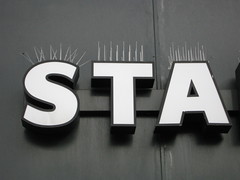Is it my imagination or has every building in urban Britain developed some kind of odd infection? A sort of rash, characterised by thousands and thousands of spikes covering every visible horizontal surface above head height?
In the love/hate relationship between the British pigeon (friend or vermin?) and the British public (friend or vermin?), these 'anti-roost spikes' are seen as the primary tool with which to spare our shopping malls of excessive avian poop.
Everywhere you look, the lines of any town centre building are serrated by these awkward-looking additions to the urban horizon. They look intrinsically uncomfortable, reminding you at every glance that they were glued there as an apologetic afterthought to the building's design.
The effect is particularly sad when seen on buildings in the 'High-Tech' style. An architect designs and builds a structure with neat, crisp industrial lines, then builders cover it with spikes so it looks like a bizarre enormous birthday cake covered in candles. Many, many candles.
You have to consider whether you'd prefer to tolerate the extra pigeon crap than these peculiar spikes breeding on every near-horizontal surface on every building. How about taking the cost of installing these spikes and putting it towards the salary of a guy with a shovel...
Other than that labour-intensive option, what can we do? There must be a better way. It's a long while since I was studying architecture but I hope that somewhere some building design experts are hard at work coming up with less visually offensive means of reducing the perceived tendency of pigeons to perch upon our buildings and shit on our heads.
The local council in Kingston-upon-Thames considered the employ of a marksman with which to dispatch pigeons and reduce their menace to the public. The resultant response in the public comments section of the Surrey Comet website article has to be one of the most humorous reads on the internet.
Of course, the best way to reduce the amount of pigeons occupying our towns is to stop feeding them. The litter and discarded food which gathers in every corner of our urban environment is what encourages our feathered rivals to compete for our living space. And, of course, we need to literally stop feeding them, as some eccentrics see fit to do. (Not only pigeons, but seagulls benefit from the generosity of certain Brighton eccentrics)
So until we change our habits, we are forced either to tolerate the hungry birds or get used to the ubiquitous spikes - surely a great way to make buildings look stupid, destroy intimacy and ruin high-tech architecture.






2 comments:
we are probably genetically programmed to do everything within our power to thwart the spread of rival colonising species - grey squirrel, seal, flea, flatworm, MRSA, rat, etc by all means possible
we have been unbelievably successful as a species - if we are directly compared to other large mammals the total human population should be about twice that of Birmingham I read somewhere.
Thank goodness our competitors don't have the wherewithall to treat us as shabbily as we do them although I daresay they would if they could!
There is a simpler solution to the pigeon problem - eat them. The same applies to other over-populated species: deer, squirrels and rabbits. Not sure about rates though *yeuk*. Proper waste disposal would have more of an affect there.
Post a Comment